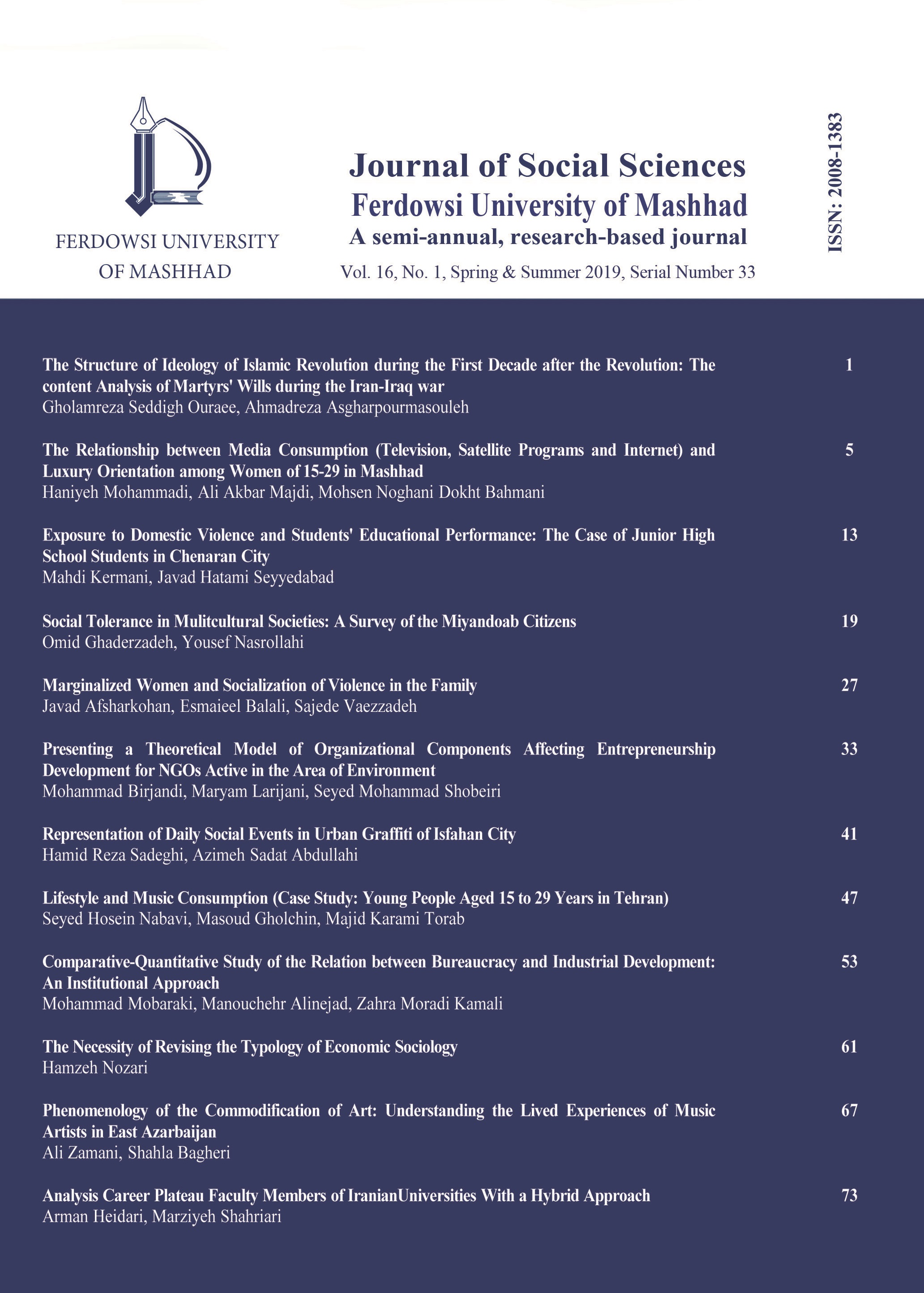Document Type : Scientific-Research
Authors
Kharazmi University
Abstract
Extended Abstract
Introduction
In sociology, art is regarded as a social phenomenon and a qualitative affair; it is considered as a historical construct which is intertwined with other aspects of human social life. During the course of history, art and works of art have always had a superior value in every society. Examination into art has been substantially important to researchers as well. Given the industrialization of societies, emergence of modernity and empowerment of capitalists systems in the world, focus on the market, commodification, and monetary exchanges between societies, the field of arts has also witnessed a number of vast changes. As cultural actors and artistic narrators, music educators are responsible for training the future generation and transferring their art to impending eras; to realize their thoughts and ideas, these artists would put forms, shapes, and various principles into test. Subsequently, conventions and aesthetic principles are born out of these experiences, explorations of form, and the use of different materials. The history of arts demonstrate the experiences of such artist. Accordingly, the present study seeks to offer theorization regarding the grounds for the emergence of the commodification of arts and the perceived implications of such commodification by art masters in Azerbaijan Sharghi using the phenomenology approach while following an inductive reasoning.
Review of Literature
There is no predetermined theoretical framework in this study. However, sensitive theoretical concepts of the study are majorly influenced by theories surrounding phenomenology. A review of the background of the study shows that the majority of studies on musical arts have employed a quantitative approach. This variable-centered, mechanical method attempts to explain the causes and social implications using predetermined theoretical approaches, comparative-hypothetical arguments, elitist attitude, environment-centeredness and the adoption of ethical approaches. Musical consumption has been the subject of studies conducted on this field; it is ultimately believed that the consumption of cultural and artistic commodities are of substantial significance due to their higher universality and accessibility. Foreign studies have addressed the role and function of music in the everyday lives and outlooks of individuals towards music. Certain research activities have explored the impact of music on the behavior of individuals as well as the effects of musical genres on their lives. Meanwhile, other inquiries have focused on the identification of individuals and the emotional influence of different types of music on the youth.
Method
The present inquiry is an in-depth study conducted using the qualitative method; it is an applied study in which the phenomenology technique was employed. The unit of analysis in this study is individuals with whom interviews were conducted so as to gain an understanding of the individual’s perception and assessment of a particular subject. The population of the study included music maestros from Azerbaijan Sharghi. Participants included Iranian, Azerbaijani, and Western Classical music maestros who own credible music teaching institutions in Tabriz and other towns of Azerbaijan Sharghi or teach in those institutes in the summer of 2016. Considering the important purposes of the study, sampling was done among those who had spent the majority of their lives on music. Samples were selected using purposive and the snowball sampling. Given the theoretical saturation of the examined questions, interviews were conducted with 10 individuals.
Results and Discussion
The results of the study included three separate sections in terms of topic: In the first section, the contextual categories of the commodification of music were addressed. In the second section, the implication of this commodification were categorized. In the final section, the adaptability and the approaches adopted by maestros against the commodification of music were discussed.
The results of the first section showed that underlying contexts of commodification in the field of music depend on the following categories: a) politicization and universality of art; b) absence of specialization and content removal; c) the clash between traditional and modern values; and d) arts as a means for exploitative marketing.
The results of the second section demonstrated the implications of commodification of music which were categorized under the two following notions: Reduced perception of art in the audience and arts serving social objectives instead of the society.
The results of the third sections presented the behavioral mechanisms of maestros with respect to the examined phenomenon and was addressed in two concepts including critical behaviors and conservative, essentialist behaviors in art.
Conclusion
Given the results of the study and its categorizations, two types of music that stand against each other were obtained. The first type is popular music which involves a reduced semantic load and musical levels and can be understood by the majority. The second type are content-centered and creative with high artistic values. Experts believe that the music of the first type is within the struggle of the market and commodification, and state the fact that the distribution of this type restricts the environment for the release of the second type. According to the findings, political platforms are also in line with such a movement in art and facilitate the commodification of music.
Considering the results of the study, it appears that attention should be paid to political, cultural, and educational strategies to reduce cultural damages caused by the commodification of music. The government’s focus and supervision on the contents of distributed music within national media, prioritizing the identification of musical genres, and enhancing the public’s understanding of content-centered and technical music would decrease such a cultural recession. Paying attention to the individual contexts of artists for the allocation of strategies is of importance as well. To this end, there is a need for more strategies to support actors who have spent the majority of their lifetime in the music industry and have formulated incredible ideas in this area; the expansion and promotion of the works of these artist can transcend the artistic field and limit the prevalence of any form of vulgarity.
Keywords

Send comment about this article